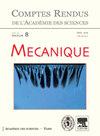模拟皮革在对流干燥过程中流体流变特性的二维模型
IF 1
4区 工程技术
Q4 MECHANICS
引用次数: 0
摘要
对非饱和可变形制品(皮革)对流干燥过程中温度、含水率和机械应力的二维时空变化进行了实验和数值研究。用数学模型描述了牛皮革样品在对流干燥条件下的响应。采用弹性介质对皮革样品进行建模,并应用了质量、热量和动量传递原理。数值计算结果与相应的实验数据吻合较好。模拟了不同干燥条件下内部温度和水分含量的变化。当干燥空气相对湿度为20%时,在最佳产品质量的最佳温度下减少了15°C。由于最佳温度的降低,获得更好质量产品的成本被最小化。所提出的弹性材料的模拟结果可以应用于皮革,这将减少所需的暴露时间为预定的最终含水量。在300 - 400s的干燥时间间隔内,试样更容易发生损伤。根据这些模拟,暴露在干燥空气中的样品表面具有最大的应力;因此,试样的表面有很高的开裂风险。我们还观察到,当最高干燥温度为60℃时,与最大应力水平相对应的样品损伤风险更高。三种皮革厚度的峰值可以在6万到14万MPa的正常应力范围内,在10000秒左右达到。本文章由计算机程序翻译,如有差异,请以英文原文为准。
2D model simulating the hydro-rheological behavior of leather during convective drying
An experimental and numerical study of a two-dimensional spatio-temporal variation of the temperature, moisture content, and mechanical stress during the convective drying process of unsaturated and deformable products (leather) were conducted. The bovine leather sample response under convective drying is described by a mathematical model. The leather sample was modeled by an elastic medium, and the mass, heat, and momentum transfer principles are applied. The numerical results agreed well with the corresponding experimental data. The variation of the internal temperature and moisture content was simulated for different drying conditions. A reduction by 15 °C was noted in the optimum temperature for best product quality when the drying air relative humidity was 20%. The cost to achieve a better quality product was found to be minimized due to the decrease in the optimum temperature. The presented simulation results of the elastic material could be applied to the leather, which will reduce the needed time of exposure for predetermined final water content. The damage of the sample is more likely to occur at the beginning of the drying in the time interval of 300–400 s. According to these simulations, the sample’s face, which is exposed to the drying air, has the highest stress; therefore, the sample’s face is at a high risk of cracking. It is also observed that the risk of damage to the sample corresponding to the maximum level of the stress is higher for the highest drying temperature of 60 °C. The peak of the three thicknesses of leather can be achieved for normal stresses in the interval of 60,000 to 140,000 MPa at around 10,000 s.
求助全文
通过发布文献求助,成功后即可免费获取论文全文。
去求助
来源期刊

Comptes Rendus Mecanique
物理-力学
CiteScore
1.40
自引率
0.00%
发文量
0
审稿时长
12 months
期刊介绍:
The Comptes rendus - Mécanique cover all fields of the discipline: Logic, Combinatorics, Number Theory, Group Theory, Mathematical Analysis, (Partial) Differential Equations, Geometry, Topology, Dynamical systems, Mathematical Physics, Mathematical Problems in Mechanics, Signal Theory, Mathematical Economics, …
The journal publishes original and high-quality research articles. These can be in either in English or in French, with an abstract in both languages. An abridged version of the main text in the second language may also be included.
 求助内容:
求助内容: 应助结果提醒方式:
应助结果提醒方式:


